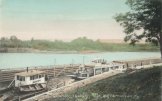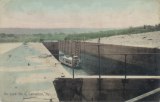
 |
 |
 |
 |
 |
Coming Thru Lock #1, Carrollton, on the Kentucky River, circa 1910
Late 1800's
 |
 |
Lock and Dam #1, 1909 |
|
 |
 |
 |
 |
 |
Lock & Dam #1, all circa 1910
 |
 |
 |
| Lock & Dam #1, Carrollton, c. 1940 | ||
In 1847, they made an exception for who had to pay tolls to lock thru.
![]()
The Hornet
“Louisville, Ky., Feb. 10. – The steamer Hornet, while ascending the Kentucky River this morning, struck the cribbing of Lock No. 1, five miles above Carrollton, Ky. and sank in twenty five feet of water. The Hornet is owned by the Kentucky and Ohio River Packet Company, and has been running from Frankfort to Louisville for some time. It is not known whether there is any insurance. She had on board a number of passengers and a large tug of freight.” The Indianapolis Sentinel, February 11, 1885 |
| Confederate Captain Jessee attacks Lock #1 on August 29, 1864, you can read about it here. | Lock #1 washes away in 1875, read it here. |
| An episode at Lock #1. | Farmers advised to get their produce to market before the dam closes for a month in 1895. |
| The bids for the building of the Keeper's Lodge at Dam #1 are here. | Story about the Indian mound they dug up to create the dam, here. |
![]()
 |
 |
| 1906 | River Scene |
 |
 |
| Brochure on the history of Lock & Dam #1 | |
![]()
| Most, if not all of these are from August 10, 1883 |  |
 |
 |
 |
 |
 |
 |
 |
 |
 |
 |
| Left, lockmen turn the capstan which operated the lock gates at Kentucky river Lock 1 on August 10, 1883. The stepped dam visible at left showing no flow over the dam indicates either an extreme drought of that river flow still passed through the breach in the dam abutment made by the river in 1881; note the timber piling on the far bank driven to close the breach was not entirely completed. The lockmen were wearing vests and doubtless posed the picture for posterity, i.e. you. | Steamer United States, August 10, 1883. Details behind the picture are here. |
||
![]()
July, 1947 plat of Lock and Dam #1
Survey showing the 1883 breach. repair
Lockmaster's House plan
![]()
| A series of 14 active locks and dams originally existed on the Kentucky River, going from Carrollton all the way to Jackson, Kentucky, 249 miles from the Ohio River. More here. |
![]()




